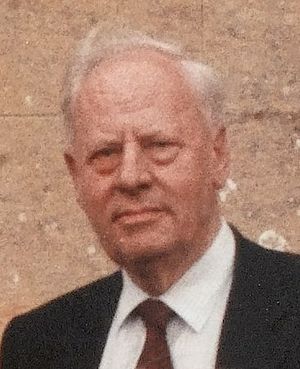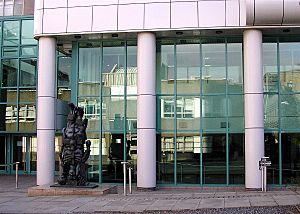Michael Swann facts for kids
Quick facts for kids
The Lord Swann
FRS FRSE
|
|
|---|---|

Swann in 1987
|
|
| Born |
Michael Meredith Swann
1 March 1920 |
| Died | 2 September 1990 (aged 70) |
| Nationality | British |
| Education | |
| Known for | The mechanisms of cell division and fertilisation |
| Spouse(s) |
Tess Gleadowe
(m. 1942) |
| Children | 4 |
| Scientific career | |
| Institutions | |
Michael Meredith Swann, Baron Swann (born March 1, 1920 – died September 22, 1990) was an important British scientist. He studied tiny parts of living things, like molecules and cells. Later in his life, he became the chairman of the BBC, which is a big media company in the UK. He also received a special honor called a knighthood and became a life peer, which meant he could sit in the House of Lords.
Contents
Early Life and Education
Michael Swann was born in Cambridge, England. He was the oldest of three children. His father, Meredith Blake Robson Swann, was a doctor who studied diseases.
Michael went to school at King's College School, Cambridge. Then he attended Winchester College, a boarding school for boys. He was a very good student there. After that, he went to Gonville and Caius College, Cambridge, to study zoology, which is the study of animals. He earned his master's degree from Cambridge.
A Scientist's Journey
Michael Swann served in the British Army during World War II. He rose to the rank of lieutenant colonel. After the war, in 1946, he started teaching zoology at the University of Cambridge, where he had studied.
In 1952, he moved to Edinburgh University to become a professor. He was elected a fellow of the Royal Society of Edinburgh in 1953. This is a group of top scientists in Scotland. Later, in 1962, he also became a fellow of the Royal Society of London, which is a very old and respected scientific group in the UK.
Studying Cells
Swann's main scientific work was about how cell division and fertilisation happen. Cell division is how cells make copies of themselves. Fertilisation is when a new living thing begins. He used special methods to understand how cells change when they divide.
He worked with another scientist, Murdoch Mitchison. Together, they found new ideas about how cells divide. He also worked with Victor Rothschild on experiments about how the outer layer of a cell changes during fertilisation.
Leading Universities and the BBC
From 1965 to 1974, Michael Swann was the leader of Edinburgh University. He was called the principal and vice-chancellor. During this time, he faced some challenges with students.
In 1972, he received a knighthood from the Queen. This meant he was now called "Sir Michael Swann."
Chairman of the BBC
From 1973 to 1980, Sir Michael Swann was the chairman of the BBC. He was chosen for this important role because of his strong leadership skills.
In 1981, he was given a special honor called a life peerage. This meant he became Baron Swann and could be part of the House of Lords, which is a part of the UK Parliament. He also became the leader of Oriel College, Oxford for a short time. From 1979 until his death, he was the Chancellor of the University of York.
Important Reports
Michael Swann also led two important reports for the government:
- In 1969, he led the "Swann Report." This report looked at how scientists, engineers, and technologists found jobs.
- In 1985, he led another "Swann Report" called "Education for All." This report studied the education of children from different ethnic backgrounds.
Michael Swann passed away in London on September 22, 1990.
Legacy and Family
The Michael Swann Building at the University of Edinburgh is named after him. This building is still used today for studying cell division and fertilisation.
In 1942, he married Tess Gleadowe. They had four children: two sons and two daughters.


